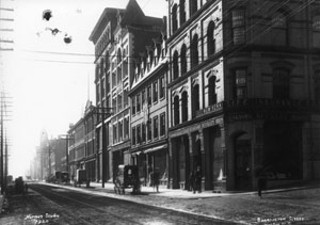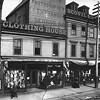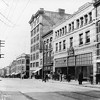The decline ofBarrington Street as the commercial and cultural heart of the city can be traced to the departure of Eaton’s from Barrington for the Halifax Shopping Centre in 1963.
That’s when architect David Garrett sees it as having really begun. “It was the harbinger of what would happen in the future---basically a flight of retail to shopping centres,” he says. “Also, with the upsurge of Spring Garden Road and the presence of significant parking and accessibility there plus the pedestrian counts that were really aided by the universities, there was a significant retail shift in the 1980s. Barrington Street has never really recovered from that.”
Garrett helped put together a November, 1998 report called Downtown Barrington: A Strategy for the Rejuvenation of Barrington Street for the Downtown Halifax Business Commission, the HRM and the province of Nova Scotia. It’s full of recommendations on how to improve the district’s urban design, how to encourage pedestrian traffic, transportation through the area and business investment at street level. Almost 10 years later it’s startling how little things have changed. If anything, the street is in worse shape now than it was then, with a flurry of business closures in the past year and shop windows draped by paper.
With the release of the 1998 report, Garrett prepared a photographic exhibition at the Mary E. Black gallery, once located in what was the Eaton’s building, at the corner of Prince and Barrington. That storefront space that is now a street-unfriendly boardroom for the Nova Scotia Department of Transportation, which currently owns the building. Though interested businesses wanted to move in when the gallery left,the province decided its staff meeting requirements superseded what was best for the street.
The exhibition brochure indicates that previous efforts in the 1980s to address the decline of Barrington Street were no more successful: “The overall situation is worse today than 10 years ago,” it states.
In the first part of the 20th century, Barrington Street south of Duke was a destination. It was Halifax’s main street, a place to go and do your shopping, banking, to have a meal, to see a show at the popular Capitol Theatre (now demolished, replaced by the Maritime Centre in 1977). It was accessible by a series of convenient and clean electric trolleys (replaced by electric trolley buses in 1949 and then just buses in 1969). “There’s a constellation of factors that have contributed to its decline over the years,” says HRM heritage planner Bill Plaskett, another contributor to that decade-old report. “In recent times big box retail conspired against Barrington and downtown streets like it in cities across the country.”
The malling of North America certainly took its toll. When the city-subsidized Bayers Lake Business Park went retail in the mid-’90s, Barrington Street took another hit, as it did back in the late-’60s--when 6.5 hectares of downtown was turned into Scotia Square, the first portion of which opened in October 1969 and the last section 11 years and $90 million later. When it opened, it boasted a Woolco department store and a 700-seat Famous Players cinema. Now those big attractions to the downtown mall are gone, and its real legacy is clear: along with the Cogswell Interchange, it cut off the north end from the downtown and helped drain Barrington of pedestrian traffic.
“They’re enclosed environments that don’t contribute anything,” says Garrett of Scotia Square and the Maritime Centre. “They largely appeal to their own contained clientele---people who work in Scotia Square or Purdy’s Wharf, which is connected to Scotia Square by the pedway. Neither contributes to the vitality of the street.”
It’s not like there haven’t been efforts to improve the situation as it worsened. Along with sheaves of well-meaning municipal reports over the years, in August 1969, Barrington between Prince and Sackville turned into an outdoor mall as a temporary yet bold measure to draw people to the street even before things got dire. It had rock gardens and “trees, shrubs and flowers growing in profusion,” wrote Bernie Raine in the Mail Star, and only public transit was allowed to drive through. In the mid-’80s there was a four-year revitalization program for the street that buried the overhead power lines and added Victorian street lamps. Nothing drew people back to the street for very long in the kinds of numbers it had before mall life and big boxes.
Paul MacKinnon has been at the Downtown Halifax Business Commission for seven years, and before that he worked for its Spring Garden counterpart. He says the two organizations representing the business interests of the downtown area meet regularly and support each other.
“The areas are linked, and what’s good for Spring Garden is going to be good for Barrington Street. We know that the customer doesn’t see a distinction,” says MacKinnon, whose office is located in the stylish, exposed-brick and hardwood third floor of 1668 Barrington, a building which he says is at capacity, much busier than it was years ago when they first moved in.
“ in fact wants to have a closer connection to Barrington Street for a more total shopping experience that can be sold to the customer, and we like that idea as well.” MacKinnon sees the high rents on Spring Garden as a benefit to Barrington, sending the smaller businesses their way. “Biscuit is a good example: they used to be in Park Lane, they moved to Argyle Street and expanded. Ryan Duffy’s is moving downtown now. It’s a natural evolution. Spring Garden will probably become more nationalized with more and more chains. We’ll probably be the next destination, maybe even for some independent retailers.”
MacKinnon points to Peep Show, Freak Lunchbox and the arrival of the Mountain Equipment Co-op on adjacent Granville in 1996 and UpCountry on Barrington in 2003 as evidence that the street is attractive to unique and successful retailers. Of course, UpCountry has departed since then. “For whatever reason, that didn’t last,” he says. “But that space was filled in by Attica. And now Attica has expanded. That’s very exciting.”
What works on Barrington is its niche specialties, says MacKinnon, and the closing of Sam The Record Man last year and The Book Room weeks ago is more indicative of their particular industries than it is of problems on the street.
“It’s one of the things that’s interesting and neat about downtown but it’s frustrating from a marketing point of view. The malls are run by much larger corporations---they’re going to get someone back in expediently and there’s a certain level of retailer they’re going to have in there. A lot of chains. Barrington Street is like the mall but it’s run by 30 different managers with 30 different ideas. Some are great business people, some of them are maybe not great business people. Usually there’s an individual story behind each one.” But MacKinnon does admit that there’s more vacant space now than in recent years, as he, and the business community, waits.
What they’re waiting for is HRM by Design and the designation of Barrington as a Heritage District, a package of $3 million in financial incentives---something that’s been in the works for years.
A number of urban renewal initiatives are being proposed, starting with defining how high buildings in the Barrington area can be built. The heritage plan that was folded into HRM by Design will offer tax incentives and grants for businesses to invest in their properties and facades, hopefully leading to a more vital, vibrant business and residential area. “It’s not just the facades of thebuildings, though that is a major part of it---there is a fundamental need for improvements and restoration,” says Bill Plaskett. “Promotion of the street can be aided by physical improvements.”
“This whole issue around development clarity,” says MacKinnon. “In fact there’s been very little development in the downtown. There’s this wait-and-see attitude because the development rules are so unclear. You propose something like the Twisted Sisters, it goes to appeal---three years after they first applied nothing’s happened yet. We’re trying to avoid that situation.” He adds that the whiff of municipal grants and hard design guidelines have actually stymied recent progress: business owners are waiting for the likely-to-be-approved plan---to go to council in May, with a public hearing June 24---to be passed before they do any major renovations so they can take advantage of the potential funding.
The new plan also encourages development to help increase population density downtown, so more people will be living on and around streets like Barrington. Mac-Kinnon points out that, contrary to popular belief, there are far fewer people living on the peninsula now than in the early ’70s (the official numbers: the 1971 census has it at 76,042, the 2006 census at 58,025). But on a finite amount of land, won’t limiting the height of residential development downtown discourage peninsular population density?
“The goal of the project is to find the balance,” says Andy Fillmore, the HRM by Design project manager, “between the modern, prosperous, bustling city and the protected heritage heights. The taller heights are definitely in the other areas of downtown. We’re bringing along new design guidelines---architecture that doesn’t have to mimic heritage in order to respect it. We’revery keen on the idea of modernity in architecture playing a vital role in improving heritage structures.”
There are a few residential buildings now on that central section of Barrington, including Barrington Gate at Blowers and the block that houses Tim Hortons on the corner of Sackville and Barrington. Developing the Roy Building is also a possibility. “My understanding is the vision in the mind of the current owner is to have a number of retail businesses at street level. I think he’s also looking at residential uses,” says Plaskett. “None of this would have the impact of a residential tower, but it would do a small part. As part of a bigger thrust.”
Garrett says to revivify Barrington is going to take focus: focus on potential business clientele and focus on access---increased parking or better transit---on top of the financial incentives and increased population density. But he says we shouldn’t forget that what made Barrington work so well in the past was that it offered something unique in the urban complexion of Halifax. “Downtown wants to remain a destination within the municipality, so it’s not just appealing to the downtown population for various activities and experiences you just aren’t going tofind elsewhere.”
Part of the HRM Urban Design Task Force and the Heritage Advisory Committee, District 12 Councillor Dawn Sloane recalls taking day trips down Gottingen and Barrington with her grandmother when she was a child in the early ’70s. Her favourite stop was Zellers, located where the Discovery Centre is now, and its toy department downstairs, where people currently shake their bootiesat Reflections.
“We have a wonderful downtown,” she says, commenting on how close and walkable the waterfront is from Barrington, Spring Garden and the Citadel. “We need to have a join-in. We need to establish the rules and help the businesses---a contiguous line of wonderful shops and boutiques. We need people living upstairs and working downstairs. We need to have something to entice someone to go downtown---to walk down the sidewalk---to need to go to Barrington Street.”





















